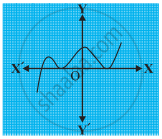Advertisements
Advertisements
Question
If the graph of a polynomial intersects the x-axis at exactly two points, it need not be a quadratic polynomial.
Options
True
False
Solution
This statement is True.
Explanation:
If the graph of a polynomial intersects the x-axis at exactly two points.
Then it may or may not be a quadratic polynomial.
As, a polynomial of degree more than 2 is possible which intersects the x-axis at exactly two points when it has two real roots and other imaginary roots.
APPEARS IN
RELATED QUESTIONS
The graphs of y = p(x) are given in following figure, for some polynomials p(x). Find the number of zeroes of p(x).

Find the zeroes of the quadratic polynomial `f(x) = 5x^2 ˗ 4 ˗ 8x` and verify the relationship between the zeroes and coefficients of the given polynomial.
Obtain all other zeroes of `(x^4 + 4x^3 – 2x^2 – 20x – 15)` if two of its zeroes are `sqrt5 and –sqrt5.`
If the sum of the zeros of the quadratic polynomial `kx^2-3x + 5` is 1 write the value of k..
If 𝛼, 𝛽 are the zeroes of the polynomial `f(x) = x^2 – 5x + k` such that 𝛼 - 𝛽 = 1, find the value of k = ?
If the zeroes of the polynomial `f(x) = x^3 – 3x^2 + x + 1` are (a – b), a and (a + b), find the values of a and b.
A quadratic polynomial, whose zeroes are -3 and 4, is ______.
A polynomial of degree n has ______.
The number of polynomials having zeroes as -2 and 5 is ______.
If the graph of a polynomial intersects the x-axis at only one point, it cannot be a quadratic polynomial.
